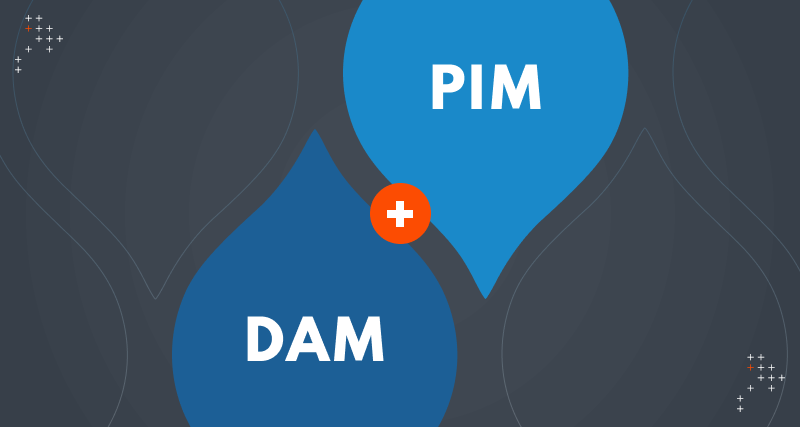Introduction
The dynamics of e-commerce are evolving. According to Forrester, global retail e-commerce sales are projected to increase from $4.4 trillion to $6.8 trillion by 2028. This highlights the urgent need to enhance the digital shopping experience, enabling buyers to move quickly with minimal friction.
Organizations can achieve this by leveraging the capabilities of Digital Asset Management (DAM) and Product Information Management (PIM) systems. Integrating DAM and PIM centralizes all technical product data, marketing content, and digital assets into a single platform. This streamlines the process for launching and optimizing successful omnichannel campaigns.
What Is Acquia DAM?
Acquia DAM, formerly known as Widen, is a digital asset management solution designed to efficiently store, manage, and distribute digital content. It serves as a central repository for an organization's digital assets, including photos, videos, graphics, PDFs, and templates.
Acquia DAM significantly improves how businesses organize, distribute, collaborate on, and securely store their digital files. A few key features of the platform include:
- Centralized Storage: All digital assets are stored in one place, ensuring easy access and organization.
- Metadata Tagging: Assets are tagged with metadata for efficient searching and retrieval.
- Security Controls: Access is restricted to authorized users, protecting sensitive content.
- Automated Workflows: Streamlines processes, reducing manual tasks and errors.
- AI-Powered Auto-Tagging: This is an additional integration that enhances asset organization and discoverability.
- Analytics: Provides insights into asset usage and performance.
- Brand Consistency: Ensures that all digital content aligns with brand guidelines.
[The DAM system] is the backbone of our marketing apparatus. It’s where we store all of our assets - photos, videos, brochures, logos - and how we serve them up.
DJ Lein | American Woodmark/Timberlake Cabinetry
How Does Acquia DAM Work?
Acquia DAM functions as a central control center, allowing approved users to upload media files, which are then tagged with metadata for easy searching and retrieval. Security features control access to assets, ensuring only authorized users can download or share content.
Automated workflows, AI-powered auto-tagging, and robust analytics enhance functionality, making it easier to transform and reuse content while maintaining control over brand consistency and digital rights management.

How Acquia DAM Helped Hootsuite Ensure Brand Consistency
Hootsuite faced significant challenges in managing their brand and marketing content due to the absence of a central repository, resulting in inefficiencies and inconsistent brand messaging. Their teams struggled to locate approved files quickly, as content was scattered across Google Drive, hard drives, and flash drives.
Recognizing the need for robust permissions and self-serve access to eliminate workflow bottlenecks, Hootsuite implemented Acquia DAM into their existing systems.
With Acquia DAM, Hootsuite organized their creative content in a single location, streamlined access through Portals, and enabled easy retrieval of brand assets. Administrative controls allowed them to adjust permissions and manage assets efficiently.
Over the past year, Hootsuite saw remarkable results, including 287,933 asset views on their blog, 14,239 downloads from the brand portal, and 575,758 embed views. Acquia DAM enabled Hootsuite to maintain brand consistency, improve creative agility, enhance collaboration across global teams, and utilize data insights for better decision-making.
It’s (Acquia DAM) just a great platform. I enjoy using it, and people have taken the system that we’ve created and used it to make something beautiful and on-brand, and I think that’s one of the best measures of success of this system.
Curtis Foreman | Hootsuite’s Senior Editor
What Is Acquia PIM?
Product Information Management (PIM) involves collecting, managing, and distributing all necessary product information from a central location.
Acquia PIM centralizes this information, ensuring consistency across channels. It helps protect and improve the quality of product information, making it easily accessible and searchable for internal and external collaborators, systems, and partners.
Acquia PIM comes with key features like:
- Centralized Data Repository: All product information is stored in a single location.
- Data Enrichment: Allows users to enhance product data with marketing copy and digital assets.
- Collaboration Tools: Facilitates collaboration on product workflows.
- Automated Updates: Ensures accurate and up-to-date product information is shared across channels.
- Taxonomy Management: Organizes product information using structured taxonomies.
- Customizable Exports: Tailors product data exports for various platforms and partners.
How Does Acquia PIM Work?
Acquia PIM streamlines internal processes to deliver accurate and high-quality product information. It collects data associated with a product, organizes it into a master profile, and allows designated users to import and enrich product data with marketing copy and digital assets.
The system also facilitates collaboration on product workflows and ensures updated product information is transmitted to e-commerce partners, print publishers, and other channels. Using taxonomies, PIM software structures product information, making it efficient to find and update data within the system and customize exports for various platforms.

How Acquia PIM Helped PRADCO Outdoor Brands Manage Their Digital Assets Effectively
PRADCO Outdoor Brands, a division of EBSCO Industries, faced significant challenges in managing their extensive content across product lines. With over 5,000 SKUs, the company struggled with inefficient workflows due to a lack of centralized storage for product data and marketing copy.
Previously, PRADCO relied on siloed spreadsheets and disjointed storage tools, which led to time-consuming processes and inaccuracies. The implementation of Acquia DAM (Widen) and Acquia PIM transformed their approach by consolidating all digital assets, product data, and marketing copy into a single, accessible system.
This integration streamlined content management, improved speed, and ensured accuracy across teams. The adoption of Acquia PIM has significantly enhanced PRADCO’s ability to manage diverse product attributes and tailor content for specific channels.
The integration has also enhanced the quality and coordination of PRADCO's digital content, ensuring exceptional customer experiences.
With Acquia DAM and Acquia PIM, everything just got a lot faster. Self-serve access to content has brought agility and speed to workflows, enabling us to focus more on strategic work rather than manual tasks.
Martin Hill | PRADCO’s Director of Digital Sales
Why Expand Acquia DAM’s Capabilities With Acquia PIM
Expanding Acquia DAM's capabilities with Acquia PIM enhances the management of both digital assets and product information, providing a comprehensive solution for e-commerce teams. By integrating DAM and PIM, organizations can create, manage, and distribute digital assets and product data more effectively, leading to:
- Improved Customer Experience: Delivering rich media assets alongside accurate product information creates a seamless and engaging customer experience.
- Operational Efficiency: Centralized management of digital assets and product information reduces manual processes and errors, streamlining workflows.
- Enhanced Marketing Capabilities: Marketers can access a 360º view of product content, including textual information, specifications, images, and videos, enabling faster and more effective campaign execution.
- Scalability: The integration supports the scaling of content and information management, ensuring consistency across all digital touchpoints.

How You Can Integrate Acquia DAM With Acquia PIM
Integrating Acquia DAM with Acquia PIM can be approached in primarily three ways.
1. Separate But Integrated DAM And PIM
Organizations often prefer using separate but integrated systems for Digital Asset Management (DAM) and Product Information Management (PIM), leveraging the unique strengths of each. This approach maintains flexibility and allows teams to use specialized tools tailored to their needs.
For example, Sargento Foods, a leading cheese producer, integrates Acquia DAM with Salsify, a popular PIM tool. In this setup, Acquia DAM is used to manage and store digital assets such as images and videos, while Salsify handles product information and e-commerce content.
The integration is achieved through APIs that synchronize data between the two systems. Completed assets in Acquia DAM are automatically pushed to Salsify, where they are enriched with product details for various e-commerce platforms. This ensures that all product content is consistent and up-to-date across channels.
Integration Steps:
- Identify the key data and assets that need synchronization between DAM and PIM.
- Utilize APIs or middleware to establish a data exchange protocol.
- Set up automated workflows to push or pull content between Acquia DAM and the chosen PIM tool.
- Regularly monitor and update the integration to handle any changes in data requirements or system updates.
2. Combined DAM And PIM
A combined solution, such as Acquia’s integrated DAM and PIM, offers a unified platform for managing both digital assets and product information. This approach simplifies workflows, making it easier to coordinate creative processes and enrich product data with assets in a single system.
For example, PRADCO Outdoor Brands utilizes Acquia’s integrated DAM and PIM to manage their extensive product catalog. With over 5,000 SKUs, the combined system provides a central location for storing and organizing product data and creative assets. This unified approach streamlines product hierarchies, ensures consistency across different distribution channels, and simplifies the management of marketing and e-commerce content.
Integration Steps:
- Implement the combined DAM and PIM solution, ensuring it meets the organization’s requirements for asset and data management.
- Configure the system to manage product hierarchies, digital assets, and metadata within a single interface.
- Develop workflows that facilitate the enrichment of product information with associated assets.
- Train teams on how to use the integrated system effectively and monitor performance to ensure it meets organizational needs.
3. Hybrid DAM For Products With PIM Integration
In a hybrid approach, Acquia DAM serves as the master repository for all product content, while specialized third-party PIM tools handle specific needs related to commerce and distribution. This method allows businesses to centralize product assets and leverage additional PIM functionalities for detailed product information management.
For example, McCormick, a global leader in spices, uses Acquia DAM to manage a comprehensive view of their product content. Acquia DAM is integrated with their PIM system to facilitate the seamless transition of product data and assets. This hybrid approach allows McCormick to maintain a central repository of digital assets in Acquia DAM while using their PIM system to manage detailed product attributes and e-commerce requirements.
Integration Steps:
- Set Acquia DAM as the central repository for digital assets and product content.
- Integrate Acquia DAM with a specialized PIM tool to handle detailed product information and e-commerce needs.
- Establish data synchronization processes to ensure that product information and assets are consistently updated across both systems.
- Configure workflows to handle the management and distribution of product content efficiently, utilizing both DAM and PIM functionalities.
By choosing the appropriate integration approach, organizations can enhance their ability to manage and distribute digital content and product information effectively, leading to improved operational efficiency and better alignment across teams.
Choosing The Right Acquia DAM & PIM Integration Approach
Selecting the right Acquia DAM and PIM integration approach for your digital experience platform relies on understanding your organization's specific needs and existing workflows.
A best-of-breed integration, where Acquia DAM and a separate PIM tool work together via APIs, is ideal for organizations seeking specialized functionalities in each system. This method offers flexibility and allows for tailored solutions that can address complex requirements, such as those seen with Sargento Foods, where DAM and PIM systems handle distinct aspects of content management and ecommerce.
On the other hand, a combined DAM and PIM approach, where Acquia’s integrated solution serves both functions, simplifies management by centralizing digital assets and product information in one platform. This unified system can streamline processes and enhance data consistency.
Alternatively, a hybrid approach can be effective for organizations that require both centralized asset management and specialized PIM features. By integrating Acquia DAM with a third-party PIM system, such as McCormick & Company’s setup, businesses can benefit from comprehensive asset management while addressing specific ecommerce and product data needs.
Each approach offers unique advantages, and the choice should be guided by your organization’s operational requirements and long-term goals.
How Axelerant Integrated DAM And PIM For A Global Composite Decking Manufacturer
Axelerant led a digital transformation for a global manufacturer of composite decking and cladding products. The client, known for their blend of British craftsmanship and cutting-edge innovation, faced challenges in managing multiple domains and delivering a consistent user experience across regions.
Axelerant and their partner Bernadette developed a Composable Digital Experience Platform (DXP) leveraging Drupal, HubSpot, and Acquia’s suite of tools, including DAM and PIM. The solution integrated Acquia DAM for efficient digital asset management and Acquia PIM to centralize product information.
This allowed the client's teams to quickly access approved photos, videos, and creative assets, significantly reducing time spent on file requests. The revamped website, with improved navigation and language detection features, provided a seamless and personalized user experience, boosting user satisfaction and conversion rates.
Have more questions about integrating Acquia DAM and PIM?
Schedule a call with Axelerant’s experts to get the answers.

Prateek Jain, Director, Digital Experience Services
Offline, if he's not spending time with his daughter he's either on the field playing cricket or in a chair with a good book.

Simran Sethi, Marketing Manager
Simran is an avid reader. She is an active runner, who also likes to swim, dance, and sing. For her, the meaning of life lies in the little things. Kindness, passion, and compassion are her life’s essential values.

 We respect your privacy. Your information is safe.
We respect your privacy. Your information is safe.



Leave us a comment